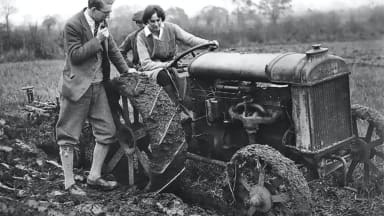
Lady Eve Balfour, born in 1898 to Scottish nobility, co-founded the Soil Association and pioneered the organic-farming movement. Raised in an era where little more was expected of women (especially of landed gentry) but to marry and bear children, Balfour was a true revolutionary. One of the first women to study agriculture, Balfour wore trousers, drove cars, tractors and even learned how to fly a (tiger moth) plane.
The daughter of a politician (Gerald Balfour, 2nd Earl of Balfour) and suffragette (Lady Elizabeth Edith ‘Betty’ Bulwer-Lytton), Balfour wasn’t afraid to speak her mind and stood up for what she believed in.
It was the Haughley experiment, conducted by Balfour and Alice Debenham in 1939, that became history. The aim of the experiment was to ascertain if there was a difference between organic and intensive farming. Between WWI and WWII organic farming had gained some attention, but Balfour’s experiment was the first of it’s kind. It is because of her ingenious experiment that we now know that:
- Organic fields can become self-supporting due to increased biological strength.
- Organic crops put more energy into establishing a healthy and expansive root system.
- Organically reared livestock require less food but produced a higher yield
The findings were published in ‘Living Soil‘ and inspired the founding of the Soil Association in 1946. Six years later, Soil Association membership had increased to 3,000 owing to the dedication of a small committee including Balfour. The Living Earth journal that they started is still running over 50 years later.
In her own words, “The health of soil, plant, animal and man is one and indivisible”.
Further reading on Lady Eve Balfour
- Soil Association, Who we are.
- CountryLife, Sarah Langford, ‘Lady Eve Balfour: the formidable woman who pioneered organic farming in Britain’, 15th of September, 2021

